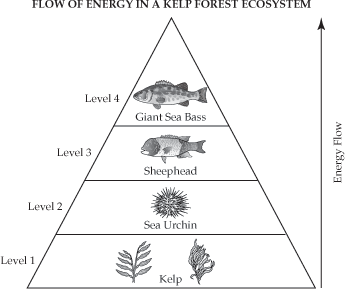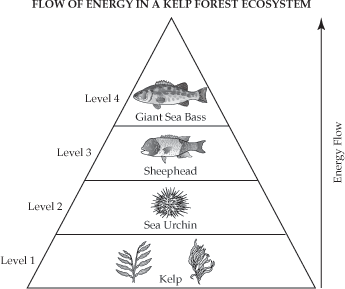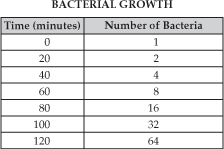Hsa Practice Test 1

HSA Practice Test 1
- 1.
A student used a microscope to observe several protists. The student sketched the protists and recorded their magnifications. The drawings and measurements are shown below. Which of these protists is the largest?
- A.
Difflugia
- B.
Stentor
- C.
Euglena
- D.
Paramecium
Correct Answer
A. DifflugiaExplanation
A and B are magnified only 4 times, so they are larger than C and D, which had to be magnified 10 times to be seen clearly. Between A and B, A (Difflugia) appears the largest.Rate this question:
-
- 2.
What is the lowest level of the energy pyramid that contains carnivores?
- A.
Level 1
- B.
Level 2
- C.
Level 3
- D.
Level 4
Correct Answer
C. Level 3Explanation
The lowest level of the energy pyramid that contains carnivores is Level 3. This is because carnivores are secondary consumers, meaning they feed on herbivores that are one level above them in the energy pyramid. Therefore, they are found at Level 3, which is the level above the primary consumers (herbivores) and below the top predators (tertiary consumers) at Level 4.Rate this question:
-
- 3.
Scientists classify humans as omnivores, based on their teeth. As omnivores, humans eat _____.
- A.
Only fungi
- B.
Mostly plants and animals
- C.
Only animals
- D.
Mostly bacteria and fungi
Correct Answer
B. Mostly plants and animalsExplanation
Think of the definition of an omnivore. That's all there is to it!Rate this question:
-
- 4.
How would the populations of other organisms in the energy pyramid be affected if the population of sea urchins suddenly decreased?
- A.
Both the kelp and the sheephead populations would increase.
- B.
Both the kelp and the sheephead populations would decrease.
- C.
The kelp population would decrease, and the sheephead population would increase.
- D.
The kelp population would increase, and the sheephead population would decrease.
Correct Answer
D. The kelp population would increase, and the sheephead population would decrease.Explanation
Kelp increases because there are fewer sea urchins eating it. Sheephead population decreases because there are fewer urchins for food.Rate this question:
-
- 5.
On Earth, water cycles through the atmosphere, oceans, land, and organisms. By what process does most of the water in plants return to the environment?
- A.
Evaporation from the roots
- B.
Condensation on the leaves
- C.
Evaporation from the leaves
- D.
Diffusion from the roots
Correct Answer
C. Evaporation from the leavesExplanation
Roots are used to absorb water, not to release it into the environment, so a and d are incorrect. Condensation on leaves would bring water to the plant, but not return it to the atmosphpere. Evaporation from leaves is the only correct choice. This is also called transpiration.Rate this question:
-
- 6.
A drop of iodine is placed in a test tube containing a sample of an unknown solution. The solution turns blue-black. This indicates that the unknown contains _________.
- A.
Glucose
- B.
Lipid
- C.
Starch
- D.
Protein/
Correct Answer
C. StarchExplanation
The blue-black color formed when iodine is added to the unknown solution suggests that the unknown contains starch. Iodine reacts with starch to form a blue-black complex. This reaction is commonly used as a test for the presence of starch in various substances.Rate this question:
-
- 7.
A piece of potato is rubbed on a small sheet of brown paper. What would you expect to see?
- A.
A wet spot
- B.
A translucent spot
- C.
Nothing at all
Correct Answer
A. A wet spotExplanation
Rubbing a piece of potato on a small sheet of brown paper would likely result in a wet spot. This is because potatoes contain a high amount of moisture, and rubbing it on the paper would transfer some of this moisture onto the paper, causing it to become wet.Rate this question:
-
- 8.
Cells, such as bacteria cells, which lack a membrane-covered nucleus and have few organelles, are called ________________.
- A.
Chloroplasts
- B.
Probiotic
- C.
Prokaryotes
- D.
Eukaryotes/
Correct Answer
C. ProkaryotesExplanation
Prokaryotes are cells that lack a membrane-covered nucleus and have few organelles. They are typically found in bacteria cells. Chloroplasts are organelles found in plant cells that are responsible for photosynthesis. Probiotic refers to live bacteria and yeasts that are beneficial for health. Eukaryotes are cells that have a membrane-covered nucleus and numerous organelles, and they include both plant and animal cells. Therefore, the correct answer is prokaryotes.Rate this question:
-
- 9.
Which of the following is a major component of cell membranes?
- A.
Carbohydrate
- B.
Lipids
- C.
Proteins/
Correct Answer
B. LipidsExplanation
Lipids are a major component of cell membranes. They form a lipid bilayer that surrounds and protects the cell, providing a barrier between the internal and external environment. Lipids are hydrophobic molecules, meaning they repel water, which helps to maintain the integrity of the cell membrane. They also play a crucial role in cell signaling, cell recognition, and the transport of molecules across the membrane. Therefore, lipids are essential for the structure and function of cell membranes.Rate this question:
-
- 10.
Which element, found in proteins, is NOT present in carbohydrates or lipids?
- A.
Carbon
- B.
Hydrogen
- C.
Oxygen
- D.
Nitrogen/
Correct Answer
D. Nitrogen/Explanation
Nitrogen is the element that is not present in carbohydrates or lipids. Carbohydrates and lipids primarily consist of carbon, hydrogen, and oxygen. Nitrogen is a key component of proteins, which are made up of amino acids. Therefore, nitrogen is unique to proteins and is not found in carbohydrates or lipids.Rate this question:
-
- 11.
Bacteria in deep undersea thermal vents store energy using inorganic compounds, not light. This process is known as __________.
- A.
Chemosynthesis
- B.
Photosynthesis
- C.
Diffusion
- D.
Mitosis/
Correct Answer
A. ChemosynthesisExplanation
The process described in the question, where bacteria in deep undersea thermal vents store energy using inorganic compounds instead of light, is known as chemosynthesis. Chemosynthesis is a process by which organisms convert chemical energy into organic compounds, without the need for sunlight. This process is commonly observed in environments where sunlight is not available, such as deep sea hydrothermal vents.Rate this question:
-
- 12.
Glucose is able to break down into two energy-packed ATPs without the help of oxygen in ______________ respiration.
- A.
Aerobic
- B.
Anaerobic
- C.
Nuclear
Correct Answer
B. AnaerobicExplanation
Anaerobic respiration refers to the process of breaking down glucose without the presence of oxygen. In this type of respiration, glucose is converted into two ATP molecules, which are energy carriers used by cells. This process is commonly observed in organisms that live in environments with limited oxygen availability, such as certain bacteria and yeast. By undergoing anaerobic respiration, these organisms are able to produce energy even in the absence of oxygen.Rate this question:
-
- 13.
A student places an Elodea plant in a test tube of water under a strong light. After a while the student notices tiny bubbles forming on the surface of the Elodea leaves. These bubbles likely contain mostly ___________.
- A.
Oxygen
- B.
Nitrogen
- C.
Carbon
- D.
Carbon dioxide
Correct Answer
A. OxygenExplanation
The plant is giving off oxygen as a product of photosynthesis.Rate this question:
-
- 14.
During prophase I, sections of homologous chromosomes switch places. What is this process called?
- A.
Binary fission
- B.
Mutation
- C.
Crossing over
- D.
Cytokinesis
Correct Answer
C. Crossing overExplanation
During prophase I of meiosis, homologous chromosomes pair up and exchange genetic material through a process called crossing over. This results in the rearrangement of sections of the chromosomes, leading to genetic variation in the offspring. Binary fission is a type of cell division in prokaryotes, mutation refers to a change in the DNA sequence, and cytokinesis is the division of the cytoplasm that occurs after nuclear division.Rate this question:
-
- 15.
A sperm cell of a fruit fly has 4 chromosomes. How many chromosomes are in the cells of a fruit fly’s leg?
- A.
2
- B.
4
- C.
8
- D.
16
Correct Answer
C. 8Explanation
Sperm cells are haploid. Therefore the number of chromosomes is 1/2 that of the leg cell. To find the leg cell, we must multiply 4 by 2.Rate this question:
-
- 16.
In a species of fly, the allele for red eyes (R) is dominant to the allele for brown eyes (r). Red eye color in the flies is not sex-linked. Students crossed male and female flies that had red eyes and recorded the eye color of their offspring. Their data are shown below. Fly Offspring Eye Color Number of Offspring Red 77 Brown 27 What are the most likely genotypes of the parent flies?
- A.
RR
- B.
Rr
- C.
Rr
- D.
RR
Correct Answer
B. RrExplanation
The most likely genotypes of the parent flies are Rr. This is because red eye color is dominant to brown eye color, so both parents must have at least one copy of the dominant allele (R) in order for their offspring to have red eyes. Since the offspring include both red-eyed and brown-eyed flies, it is likely that one parent is heterozygous (Rr) and the other parent is homozygous recessive (rr).Rate this question:
-
- 17.
Which of the following processes occurs ONLY in plants?
- A.
Respiration
- B.
Mitosis
- C.
Photosynthesis
Correct Answer
C. PhotosynthesisExplanation
Photosynthesis is the process that occurs only in plants. It is the process by which plants convert sunlight, carbon dioxide, and water into glucose and oxygen. During photosynthesis, plants use chlorophyll to capture sunlight energy and convert it into chemical energy, which is stored in the form of glucose. This process is essential for plants to produce their own food and release oxygen into the atmosphere. Respiration, on the other hand, occurs in both plants and animals, while mitosis is a cell division process that occurs in all living organisms.Rate this question:
-
- 18.
In rabbits, short fur (F) is dominant to long fur (f). What are the chances that two heterozygous short-haired rabbits will have offspring with short fur?
- A.
100%
- B.
75%
- C.
50%
- D.
25%
Correct Answer
B. 75%Explanation
When two rabbits are heterozygous for short fur (Ff), there are three possible genotypes for their offspring: FF, Ff, and ff. The dominant allele F will result in short fur, so both FF and Ff genotypes will have short fur. Only the ff genotype will have long fur. Therefore, 75% of the offspring will have short fur (FF and Ff genotypes), while 25% will have long fur (ff genotype).Rate this question:
-
- 19.
Oxygen levels increase in a pond during the day. This happens as a result of what process?
- A.
Respiration
- B.
Replication
- C.
Photosynthesis
Correct Answer
C. PhotosynthesisExplanation
During the day, plants in the pond undergo photosynthesis, a process in which they use sunlight, carbon dioxide, and water to produce oxygen and glucose. This leads to an increase in oxygen levels in the pond. Respiration, on the other hand, is the process by which organisms use oxygen to break down glucose and release energy. Replication is the process of copying DNA during cell division and is not related to the increase in oxygen levels in the pond.Rate this question:
-
- 20.
The following table provides data on the population growth of bacteria over time. According to the data table, which of the following is true?
- A.
The graph of data would be a straight line with a slope of 2.
- B.
The number of bacteria doubles every twenty minutes.
- C.
At 140 minutes, there should be about 96 bacteria.
Correct Answer
B. The number of bacteria doubles every twenty minutes.Explanation
The correct answer is "The number of bacteria doubles every twenty minutes." This can be inferred from the data table provided. The number of bacteria increases from 12 to 24 in 20 minutes, from 24 to 48 in the next 20 minutes, and so on. This consistent doubling of the bacteria population every 20 minutes indicates that the statement is true.Rate this question:
-
Quiz Review Timeline +
Our quizzes are rigorously reviewed, monitored and continuously updated by our expert board to maintain accuracy, relevance, and timeliness.
-
Current Version
-
Mar 22, 2023Quiz Edited by
ProProfs Editorial Team -
Apr 14, 2011Quiz Created by
Kath0915
 Back to top
Back to top





